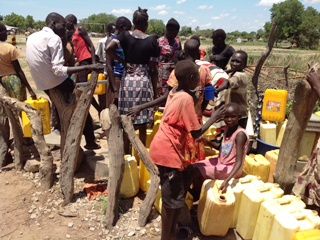Water shortages hit S. Sudanese refugees in Uganda
April 21, 2014 (ARUA) – An estimated nearly 15,000 South Sudanese refugees currently living at Rhino camp refugee settlement in the West Nile region of Uganda have been hit by severe water shortage, a condition which piles more misery to their dire humanitarian situation.

Women and children, on a daily, line up for up for up to two hours or even more to pump water from the few boreholes or nearby water supply tanks.
Over a million South Sudanese have reportedly been displaced since fighting broke out in the country’s capital, Juba in mid-December last year. An estimated 280,000 have since been displaced to neighbouring countries, including Uganda.
Sarah Nyagut Ding spends about an hour and a half every day, waiting for her turn to draw water from a pump in the Ocea sector in Rhino resettlement camp in Uganda.
Ding is one of more than 4,000 South Sudanese refugees who have lived in the tightly packed Ocea cluster since fighting broke out in South Sudan more than four months ago.
The refugees are not only battling homesickness and fear for the future of their country, but also tough challenges in the camp, including a chronic shortage of clean water that has led to tensions with the local community.
Women like Ding wait in line for hours to pump water from boreholes or to draw their share of water from 10,000-liter tanks.
Because the refugee population at the settlement has doubled in the past four months, and because the refugees are competing with locals for water, very often, Ding and the others go home from the pump empty-handed.
“Most of us stay a week without bathing. Some of us go to a nearby dirty stream to collect water. We try to treat the dirty water with ash tree to kill the germs so we can drink it,” she said.
The lack of water has led to fights between locals and refugees, another South Sudanese refugee, Kidden Ester, said.
“Sometimes, the natives threaten the Sudanese and then they start fighting,” Ester said.
Simon Peter, the chair of a committee set up by the refugees in the Ocea cluster, said there simply is not enough water to go around at the settlement.
“We have four boreholes. One of them is OK — it can give us enough water — but the other three, if you pump to fill one jerry can, it will take half an hour. And sometimes after four or six jerry cans, the water will stop,” he said.
Another problem is that the 10,000-liter water tanks are not always delivered. When they don’t show up, refugees have to go without water for days, Peter said.
David Abili, the assistant settlement commander said camp authorities are working to address the water problem by bringing in a specialist company to drill for water, and community leaders are trying to patch things up between locals and the refugees.
South Sudan – the world’s newest nation, could face one of the most devastating famines to date in a matter of weeks, if radical action to alleviate widespread hunger are not taken before the planting season, UN agencies warned in their report.
An estimated $230 million, the UN said, is urgently needed to help address the dire humanitarian situation, which puts about 3 million people at risk of starvation.
(ST)
